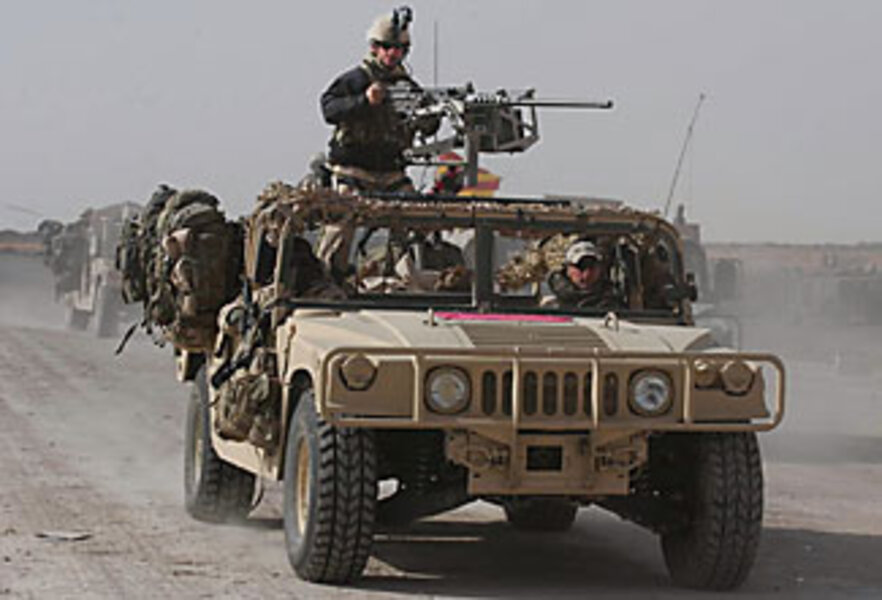Military looks for Humvee successor
Loading...
| Washington
The military is on the hunt for a new jeep to replace its cold war-inspired Humvee.
The Joint Light Tactical Vehicle, or JLTV, will have all the latest gadgets that one might expect in a new military vehicle, including a "collision avoidance system." But military officials and outside analysts know that it's not just a new truck replacing an old one. Seven years of unconventional or counterinsurgency warfare is forcing the American military to recognize that the threat it's up against isn't an aberration and that the "jeep of the future" must navigate this dangerous new world.
"Buying a new light truck might not seem like a big deal, but the message of Iraq and Afghanistan is that trucks might be more important than tanks in future war fighting," says Loren Thompson, a senior analyst with the Lexington Institute, a policy research group in Arlington, Va.
Next month, the Army and Marine Corps are expected to pick three preliminary designs for the new vehicle, and the winning one could be picked by 2011. Roughly 200,000 vehicles could be produced under the plan, but they won't be in the hands of the military until probably 2013, officials say.
The Humvee, first introduced in 1984, was considered a major leap forward from the classic American military jeep. Heavy, low-slung, and extra wide, the Humvee represented the new standard in tactical vehicles for the combat of that era. But in many ways, it was designed when the US still occupied a cold-war mind-set and thought its vehicles would be used in a conventional combat environment with front lines and rears. Now, the kind of unconventional warfare the military finds itself engaged in dictates a kind of truck that protects troops better, is easier to modify, and is generally faster on its feet.
The Humvee had maneuverability, handling, and logistical challenges, but the limitations of the vehicle really surfaced when the military began hanging body-armor plates on it to protect troops from roadside bombs. The metal added thousands of pounds of weight, which increased brake, suspension, and drivetrain wear. The new vehicle, however, will already be designed to keep troops safe.
"The Humvee offered great cross-country mobility until we started armoring it up," says Lt. Col. Ben Garza, a Marine project manager for the JLTV. "We want to maintain the same kind of cross-country performance, but with a vehicle with those protection levels built into it."
At least a half-dozen companies, each with multiple partners, are reportedly bidding on the JLTV: Defense contractors BAE-Navistar, Boeing-Textron, Northrop Grumman-Oshkosh, and Lockheed Martin all appear to have submitted designs. Furthermore, General Dynamics is teaming with AM General, the "incumbent" maker of the Humvee. Another partnership that is expected to bid includes Force Protection Inc., which makes Mine Resistant, Ambush Protected vehicles.
The military, designers say, is looking for a "25 percent improvement" on many aspects of the Humvee design. For example, designers must submit a plan with an "electronic backbone" built in to make it easier to use different kinds of communications gear and better integrate various vehicle systems, including the vehicle's own diagnostic, tire inflation, and security systems. Maintenance must also be easier.
In addition, the vehicle must achieve greater fuel economy. Still, despite rising fuel costs, and the already hefty fuel bill that the Pentagon pays, the military did not stipulate that bidders build a hybrid vehicle.
"It's not a requirement," says Lt. Col. Wolfgang Petermann, the Army's project manager for the vehicle, regarding a hybrid. Bidders are free to submit a hybrid design, but the military isn't sure the technology is ready to be applied to the rigors that a military truck must endure.
In the secretive world of defense acquisition, Boeing company representatives say they've been "silent on the issue" of a hybrid-powered vehicle. But they pointed to a concept vehicle built by them that was a hybrid and shown at the Army's annual convention in Washington last fall.
"We'd like to have the highest fuel efficiency while it's also safe," says Jerry McElwee, vice president for Boeing Advanced Systems. "The conflict we're in now, we need not only good transportation, but a highly survivable means of transportation."





